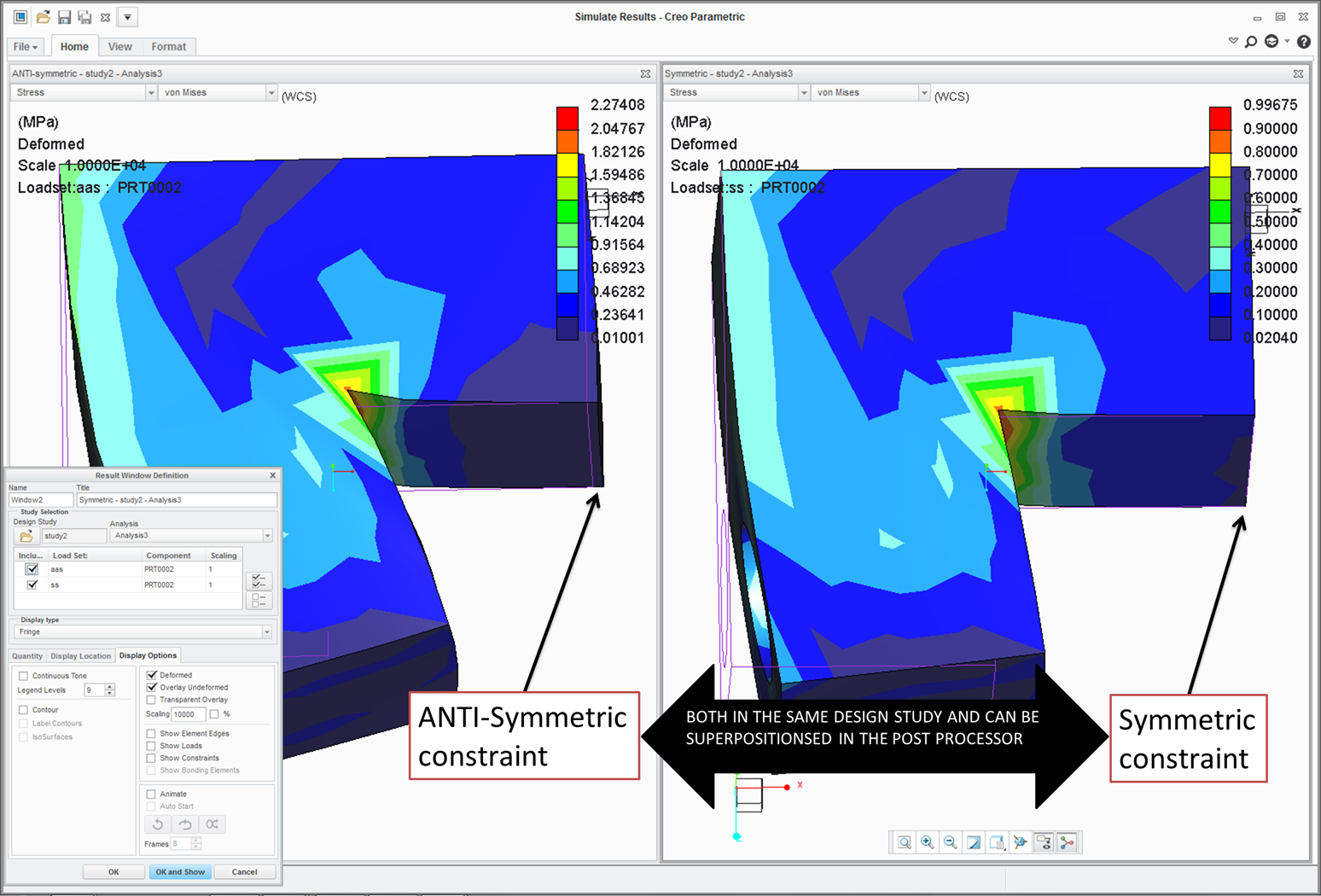Community Tip - Need to share some code when posting a question or reply? Make sure to use the "Insert code sample" menu option. Learn more! X
- Community
- Creo+ and Creo Parametric
- Manufacturing (CAM)
- Re: Anti-symmetric loading, symmetric geometry
- Subscribe to RSS Feed
- Mark Topic as New
- Mark Topic as Read
- Float this Topic for Current User
- Bookmark
- Subscribe
- Mute
- Printer Friendly Page
Anti-symmetric loading, symmetric geometry
- Mark as New
- Bookmark
- Subscribe
- Mute
- Subscribe to RSS Feed
- Permalink
- Notify Moderator
Anti-symmetric loading, symmetric geometry
Hi,
A (very) long while since I did this but none the less a useful method. I used to do it in Independent and wanted use the method in Creo but can't.
A geometrically symmetric model but the loads are not. We want to reduce the model size by exploiting the symmetry of the geometry.
Conclusion - we can't, run the full model.
Alternative - add the symmetric and anti-symmetric results (superposition).
Independent Method - run 2 models
1. With symmetry boundary condition & symmetric part of the load
2. With anti-symmetric boundary condition & anti-symmetric part of the load
3. Add the results in the post processor by:
4. Manually copying the result files from 2. into 1.
5. Reopening the model for 1 and selecting 2 loadsets which invoked the 'combine' function in the post processor when opening the results for 1.
In other words, we fool the post processor. It was Ok, it's not pretty but it worked fine
Ok, I will accept that this is running a half model twice and so time savings are probably non-existent; but I can get more model in my memory if it is only a half model.
With Creo the files have changed. I have a feeling I need to run in a design study to keep the mesh numbering consistent and I need to change file names and edit headers in results files.
Has anyone done this in Creo?
Thanks
- Labels:
-
General
- Mark as New
- Bookmark
- Subscribe
- Mute
- Subscribe to RSS Feed
- Permalink
- Notify Moderator
It can be done. If interested:
BUT it is less efficient as there are 4 models run rather than 2 as in the old (version 20 and before?) days
Create
- anti-symmetric loadset
- symmetric loadset
- anti-symmetric constraint set
- symmetric constraint set
Create 2 analyses
Analysis1
- Anti symmetric constraint
- BOTH loadsets NOT combined
Analysis2
- Symmetric constraint
- BOTH loadsets NOT combined
Create STANDARD design study containing:
Study1
- Analysis1
- Analysis2
Run the design study and each analysis will be run for each loadset; 4 analyses.
Using the design study keeps the mesh numbering consistent.
Using the design study ensures that all files are called 'STUDY1.xxx'
\Study1\Analysis1 subdirectory will contain results for both loadsets against Anti-symmetric constraints
- study1.s01, study1.d01 etc
- study1.s02, study1.d02 etc **
\Study1\Analysis2 subdirectory will contain results for both loadsets against Symmetric constraints
- study1.s01, study1.d01 etc
- study1.s02, study1.d02 etc *
Manually copy the Analysis2 files ending in *.*02 marked above with *
and replace the Analysis1 files marked ** with these.

A limited methodology.
Have fun.
- Mark as New
- Bookmark
- Subscribe
- Mute
- Subscribe to RSS Feed
- Permalink
- Notify Moderator
Hi Charles,
thanks a lot for posting this, since I also recognized some time ago it did not work any more and had no time to try out how it works now.
For interested users, I attach an old paper from Herbert Diehl describing in more detail how the method worked in Mechanica 8.0 (! :-)). I also add two simple models that may help users to understand what an "anti-symmetric" constraint is. It's a bit tricky!
Best,
Roland
- Mark as New
- Bookmark
- Subscribe
- Mute
- Subscribe to RSS Feed
- Permalink
- Notify Moderator
Roland,
I had a rare spare moment and it was annoying me.
The Mechanica method was faxed to me (Ronald Fuchs??) at about the time PTC acquired RASNA.
It is not as efficient now. Could it be a more trivial enhancement?
bfn
Charles
... Do we still have faxes?
- Mark as New
- Bookmark
- Subscribe
- Mute
- Subscribe to RSS Feed
- Permalink
- Notify Moderator
Charles,
Long ago that Ronald Fuchs worked for the PTC (Rasna) Technical Support, unfortunately. A good guy...
I think it should be a trivial enhancement. The PP simply should be able to combine and scale load cases from different analyses, as long as their meshes are identical. The rest should be in the responsibility of the user - he has to judge if linear superposition is valid or not for the actual problem. But the problem are the resources PTC still has that could code enhancements. Simply not enough... 😞 I have tons of ideas what should (and must!) be enhanced to eliminate all the cumbersome functionality gaps you face in daily application, and you have to work around - if possible at all. Hopefully sometime in the future PTC remembers that structural simulation is an essential part of product development. Currently it seems to be completely out of focus of the top management. Very sad.
Nice Weekend,
Roland
...I still have a fax. But it does not work any more 😉


